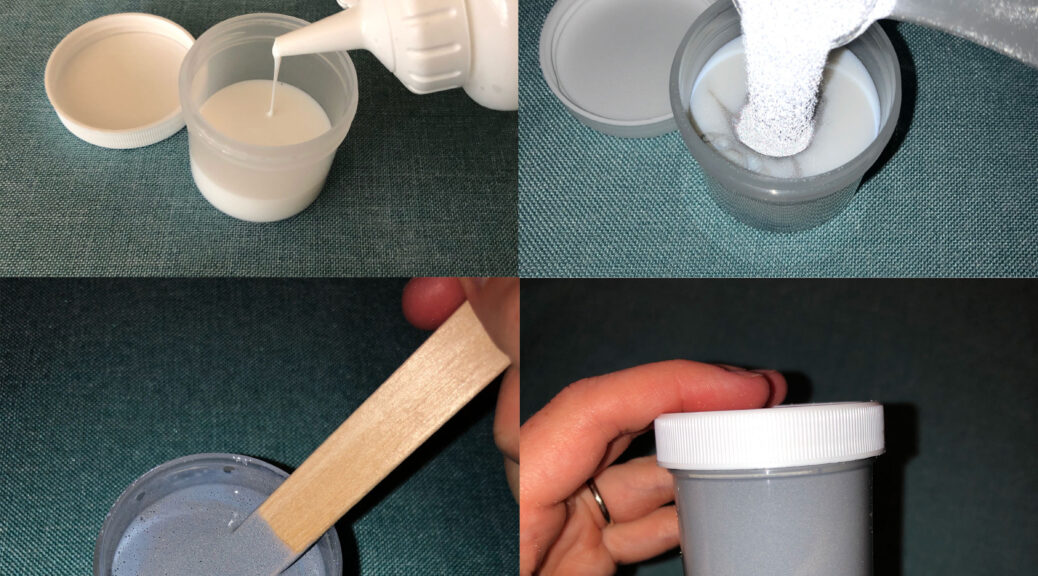This article outlines the history and development of Intermixed or Premixed Retro Reflective Paint from its beginning until the present. To be intermixed or premixed simply means that the reflective elements are already in the solution, making application a one part or one step process.
What is Reflective Paint?
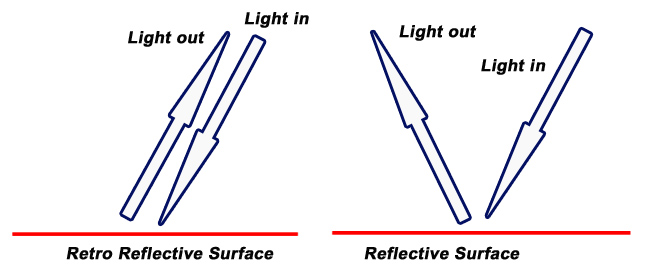 Before we discuss the history of retro reflective paint, let’s talk about what it is and what function it serves in society. Retro reflective paint is a substance which is spread over a surface that dries or cures to leave a thin coating. Reflective paint is different from normal paints in that at night it returns or redirects light that strikes it back to the source of that light. This return of light makes the paint appear bright white to a viewer who is in line with the returning light. For the viewer, this bright return of light contrasts the painted surface from the surrounding surfaces and objects nearby. (When you see a street sign at night that it illuminated by your headlights, you are experiencing the same effect.)
Before we discuss the history of retro reflective paint, let’s talk about what it is and what function it serves in society. Retro reflective paint is a substance which is spread over a surface that dries or cures to leave a thin coating. Reflective paint is different from normal paints in that at night it returns or redirects light that strikes it back to the source of that light. This return of light makes the paint appear bright white to a viewer who is in line with the returning light. For the viewer, this bright return of light contrasts the painted surface from the surrounding surfaces and objects nearby. (When you see a street sign at night that it illuminated by your headlights, you are experiencing the same effect.)
Note – Reflective means to return or bounce light, and retro reflective means to return light back to its source. A mirror is reflective, and reflective paint or reflective sheeting is retro reflective.
History of Reflective Paint.
As stated before, there are two main components for reflective paint. One is paint, normally clear, and the other would be glass spheres or beads. There are other components used in the paints, however, these are the main ones. Paint itself was invented thousands of years ago, however, perfectly round reflective beads are not that old, and you need both to create retro reflective paint. So before anyone could invent reflective coatings, they needed reflective beads.
 In 1914, Rudolph Potters developed a method for creating perfectly round glass spheres that would reflect light back to the light source. He found that by dropping hot molten glass, it would form an almost perfect sphere as it fell. So he developed a controlled way to produce perfectly round beads. His patent was for the method of creating glass spheres, and the apparatus or machinery needed for the process. This was an important invention and revolutionized the safety and traffic industry. From this invention came reflective road lines, reflective tape, movie screens, reflective clothing, and more. In 1941, he patented his invention. From that time until now, Potters Beads has filed for about 100 patents. The first patent in the glass bead field was titled the “Method and Apparatus for Producing Glass Beads“.
In 1914, Rudolph Potters developed a method for creating perfectly round glass spheres that would reflect light back to the light source. He found that by dropping hot molten glass, it would form an almost perfect sphere as it fell. So he developed a controlled way to produce perfectly round beads. His patent was for the method of creating glass spheres, and the apparatus or machinery needed for the process. This was an important invention and revolutionized the safety and traffic industry. From this invention came reflective road lines, reflective tape, movie screens, reflective clothing, and more. In 1941, he patented his invention. From that time until now, Potters Beads has filed for about 100 patents. The first patent in the glass bead field was titled the “Method and Apparatus for Producing Glass Beads“.
 Once Rudolph Potters and his brother Paul formed Potters Beads and began mass production, several inventions and patents that utilized their invention quickly followed. The reflective movie screen was one of the first inventions or applications. You have most likely heard the term “silver screen” when referring to theaters. This term came about because in the 1910’s, movie screens were coated with a reflective paint that gave them a silvery appearance. The screens reflected light back towards the camera and the audience, giving a better experience. The beads used for these screens were Potters Beads. So the first real mention of a reflective coating or paint being used in commerce would have been for movie screens. At that time, the actual reflective paint used to coat the movies screens was invented, but not patented. An official patent of a reflective coating would take place years later for an entirely different application.
Once Rudolph Potters and his brother Paul formed Potters Beads and began mass production, several inventions and patents that utilized their invention quickly followed. The reflective movie screen was one of the first inventions or applications. You have most likely heard the term “silver screen” when referring to theaters. This term came about because in the 1910’s, movie screens were coated with a reflective paint that gave them a silvery appearance. The screens reflected light back towards the camera and the audience, giving a better experience. The beads used for these screens were Potters Beads. So the first real mention of a reflective coating or paint being used in commerce would have been for movie screens. At that time, the actual reflective paint used to coat the movies screens was invented, but not patented. An official patent of a reflective coating would take place years later for an entirely different application.
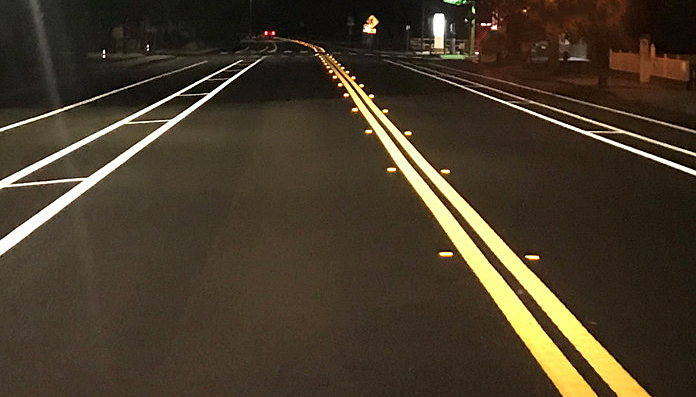 Overwhelmingly, the largest application for reflective glass beads is in the highway safety market. Reflective glass beads are used all over the world in massive quantities to make painted road stripes and thermoplastic road stripes reflective. And because lines wear away, the demand is never ending. So from the beginning, for the most part, road striping reflectivity is what the beads created by Potters Beads have been used for. As a side note, to create a reflective road stripe you simply put down a layer of paint or hot thermoplastic, apply glass beads to the surface where they form a bond and remain exposed, and you have a bright reflective line that can be seen day and night in dry and wet conditions. There is no way to count all the lives that have been saved by this invention and its application in the road striping industry.
Overwhelmingly, the largest application for reflective glass beads is in the highway safety market. Reflective glass beads are used all over the world in massive quantities to make painted road stripes and thermoplastic road stripes reflective. And because lines wear away, the demand is never ending. So from the beginning, for the most part, road striping reflectivity is what the beads created by Potters Beads have been used for. As a side note, to create a reflective road stripe you simply put down a layer of paint or hot thermoplastic, apply glass beads to the surface where they form a bond and remain exposed, and you have a bright reflective line that can be seen day and night in dry and wet conditions. There is no way to count all the lives that have been saved by this invention and its application in the road striping industry.
Note – Potters Beads remains the oldest and largest producer of glass beads in the world.
In the late 1930’s and 40’s, a company called 3m became very interested in retro reflective traffic products. If you look at their current product offerings in this area, you can see that their interest paid off. Many people know that 3m invented what we now know as reflective tape or sheeting for traffic signs, however, what some do not know is that this product came from an effort to create reflective road stripes. The product they first attempted consisted of glass beads embedded in an adhesive film that could be adhered to the road. It worked, however, longevity was an issue so the idea for using this invention for road stripes was shelved. It was not a total loss however, because the concept led to the creation of retro reflective sheeting in 1941, an invention that literally changed the world of night time driving. But 3m was not at all done with trying to invent a reflective road striping product.
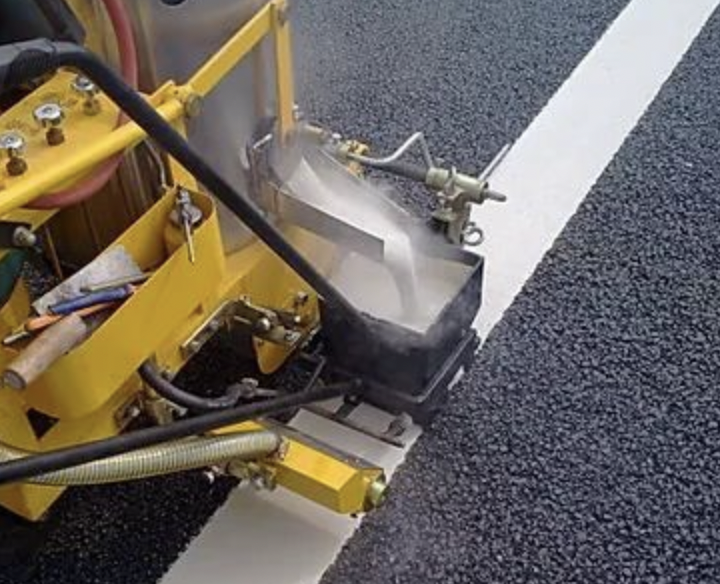 As previously mentioned, up until the late 40’s, road stripes were made reflective by first applying a layer of paint, and then going over the wet paint with glass beads. This two step process is often called the drop on method and the beads are referred to as drop on highway beads. This method was used in the very beginning and is still used today. The beginning of the development of retro reflective paint relates to the desire of inventors to take the two steps of the drop on method and combine them into one step. This seems fairly simple, however, as with any process or invention, there were problems to solve.
As previously mentioned, up until the late 40’s, road stripes were made reflective by first applying a layer of paint, and then going over the wet paint with glass beads. This two step process is often called the drop on method and the beads are referred to as drop on highway beads. This method was used in the very beginning and is still used today. The beginning of the development of retro reflective paint relates to the desire of inventors to take the two steps of the drop on method and combine them into one step. This seems fairly simple, however, as with any process or invention, there were problems to solve.
Note – the problem that inventors were trying to overcome was the tendency of glass beads to sink in a solution and not stay on the surface. Because to reflect, glass beads need to be exposed on top of the painted surface so that light can enter and be returned.
In 1949, the 3m company developed and patented a paint that premixed glass beads in with paint. The product would be sprayed onto a road surface and when dry, would create a reflective stripe. The patent was named “Highway Marking Paint Containing Glass Beads“. Since glass spheres were all the way through the layer of paint, as the lines wore, new glass beads would be exposed so that reflectivity was maintained over time. This invention and method can be known as an intermix method versus a drop on method where the paint is applied first, and then beads to the surface. The invention worked, however, the drop on method has remained to this day, the most popular way to create reflective road markings. This patent expired in 1968.
Note – reflective paint inventions were working, however, they did not reflect as well as simply dropping beads on wet paint. Because of this, they did not meet highway standards. An excerpt from a subsequent patent explains why. It is as follows –
In the United States patent to Heltzer, No. 2,574,971, dated November 13, 1951, Highway Marking Paint Containing Glass Beads, the glass spheres or beads were incorporated in the paint and the paint and the glass spheres applied together in a single stage. The paint film above the beads of this composition is worn away to expose the tops of the beads and in this manner a reflex reflective surface is developed through wear. The durability of the reflex reflective action, although somewhat improved, does not provide the high standards of nighttime visibility for adequately long periods of time.
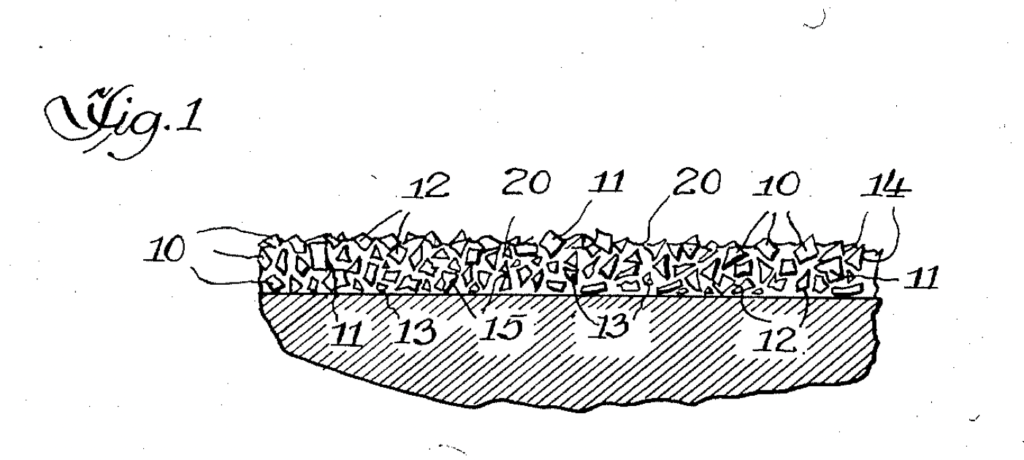 In 1956, another reflective paint was invented by American Marietta. This invention was simply called “Centerline Paint“. This invention would use what is called Specular or Mirror reflectivity instead of Retro Reflective Glass Spheres. Reflective crushed glass was mixed with paint to create little mirrors in the surface that would reflect light back to car headlights. Crushed glass also created a non skid surface, whereas glass beads created a potentially slippery surface when wet. This patent expired in 1975.
In 1956, another reflective paint was invented by American Marietta. This invention was simply called “Centerline Paint“. This invention would use what is called Specular or Mirror reflectivity instead of Retro Reflective Glass Spheres. Reflective crushed glass was mixed with paint to create little mirrors in the surface that would reflect light back to car headlights. Crushed glass also created a non skid surface, whereas glass beads created a potentially slippery surface when wet. This patent expired in 1975.
In 1958, American Marietta updated their invention of reflective road marking paint to include larger glass spheres in their paints. This added brightness to the invention while maintaining the non skid characteristics of the line. This invention or patent was named “Road Marking Paint“. The patent for this invention expired in 1978.
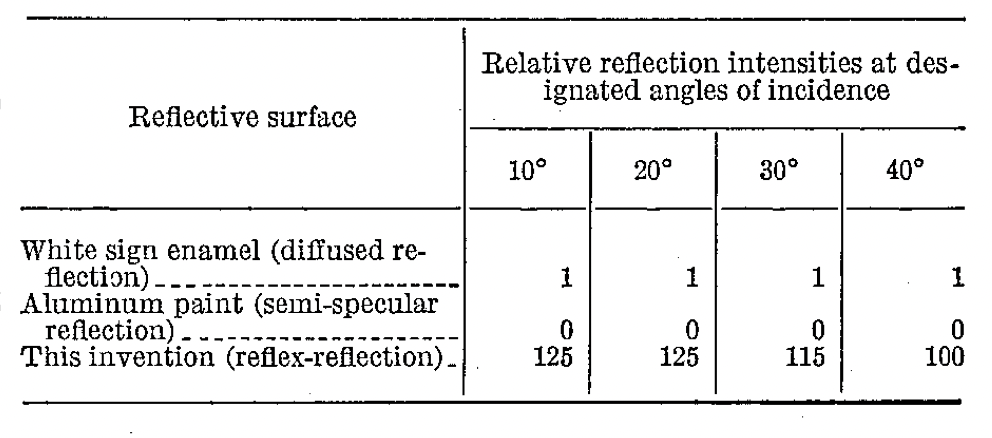 In 1966, 3m created yet another reflective paint that they initially called “Reflective Coating Compositions Containing Glass Beads, Metal Flake Pigment and Binder“. This was probably the most creative iteration of this product in that it added components to both increase reflectivity, and add color to the coating. This was accomplished through the use of colored metal flakes that were smaller than the glass beads. Once applied, and while still in a liquid form, the flakes would settle behind the beads and offer a colored reflective background. Also, higher index beads were used for this product. This product was different from previous ones in that it was intended to be used by sign makers who wanted an easy one step way to create a sign background. For example, if a bill board needed to be seen at night, certain elements of that sign could be made reflective so that oncoming traffic would see it. This is done today with larger rolls of self adhesive reflective sheeting. The patent for this product expired in 1983.
In 1966, 3m created yet another reflective paint that they initially called “Reflective Coating Compositions Containing Glass Beads, Metal Flake Pigment and Binder“. This was probably the most creative iteration of this product in that it added components to both increase reflectivity, and add color to the coating. This was accomplished through the use of colored metal flakes that were smaller than the glass beads. Once applied, and while still in a liquid form, the flakes would settle behind the beads and offer a colored reflective background. Also, higher index beads were used for this product. This product was different from previous ones in that it was intended to be used by sign makers who wanted an easy one step way to create a sign background. For example, if a bill board needed to be seen at night, certain elements of that sign could be made reflective so that oncoming traffic would see it. This is done today with larger rolls of self adhesive reflective sheeting. The patent for this product expired in 1983.
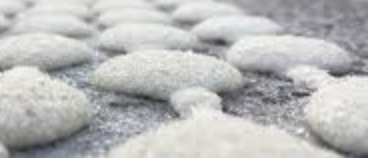 In 1977, 3m filed for a patent referred to as a “Retro-Reflective Liquid Coating Composition“. The patent was granted in 1982. The invention was unique in that it was a gel type coating or paint. The gel consistency kept the beads in suspension, and the solvents in the coating caused the mixture to dry quickly. When it dried, the coating formed little domes or mounds on a surface that were instantly retro reflective. These raised reflective domes or mounds provided retro reflectivity at more angles than a standard flat surface. The stated purpose of the invention is as follows – A coating composition useful, inter alia, to form mound-shaped retroreflective marks that rapidly actuate photo scanner sensing devices. The patent for this invention expired in 1999.
In 1977, 3m filed for a patent referred to as a “Retro-Reflective Liquid Coating Composition“. The patent was granted in 1982. The invention was unique in that it was a gel type coating or paint. The gel consistency kept the beads in suspension, and the solvents in the coating caused the mixture to dry quickly. When it dried, the coating formed little domes or mounds on a surface that were instantly retro reflective. These raised reflective domes or mounds provided retro reflectivity at more angles than a standard flat surface. The stated purpose of the invention is as follows – A coating composition useful, inter alia, to form mound-shaped retroreflective marks that rapidly actuate photo scanner sensing devices. The patent for this invention expired in 1999.
As far as can be determined, there are no active patents for reflective paints, and since every conceivable way of creating it using glass beads has been exhausted, there most likely never will be. In other words, reflective paint is in the public domain and has been for decades.
With that being said, there are many reflective paints available on the market today. Some are spray aerosol, some are liquid and brush (or roller) applied, and others are in the form of inks that are applied by the silk screening process. Some common uses are small scale projects like crafts or hobbies, bicycle reflectivity, personal safety (garments), dog collar visibility, parking lot logos, odd shaped object marking (reflective), and much more.
In almost all cases, the goal of the application of retro reflective paint, is night time safety through visibility. And for the most part, this occurs in automobile traffic where the lack of night time visibility can be fatal. So although attempts to replace the drop on reflective road striping method did not pan out as expected, reflective coatings are very much a part of modern day personal safety, just in different applications. Reflective paints and Reflective Sheeting (tape) both serve to light up the night, and keep people safe.
For more information about reflective paints and tapes, read our article on Reflective Paint versus Reflective Tape. And as always, if you have any questions, feel free to contact us using the contact link to the left.
